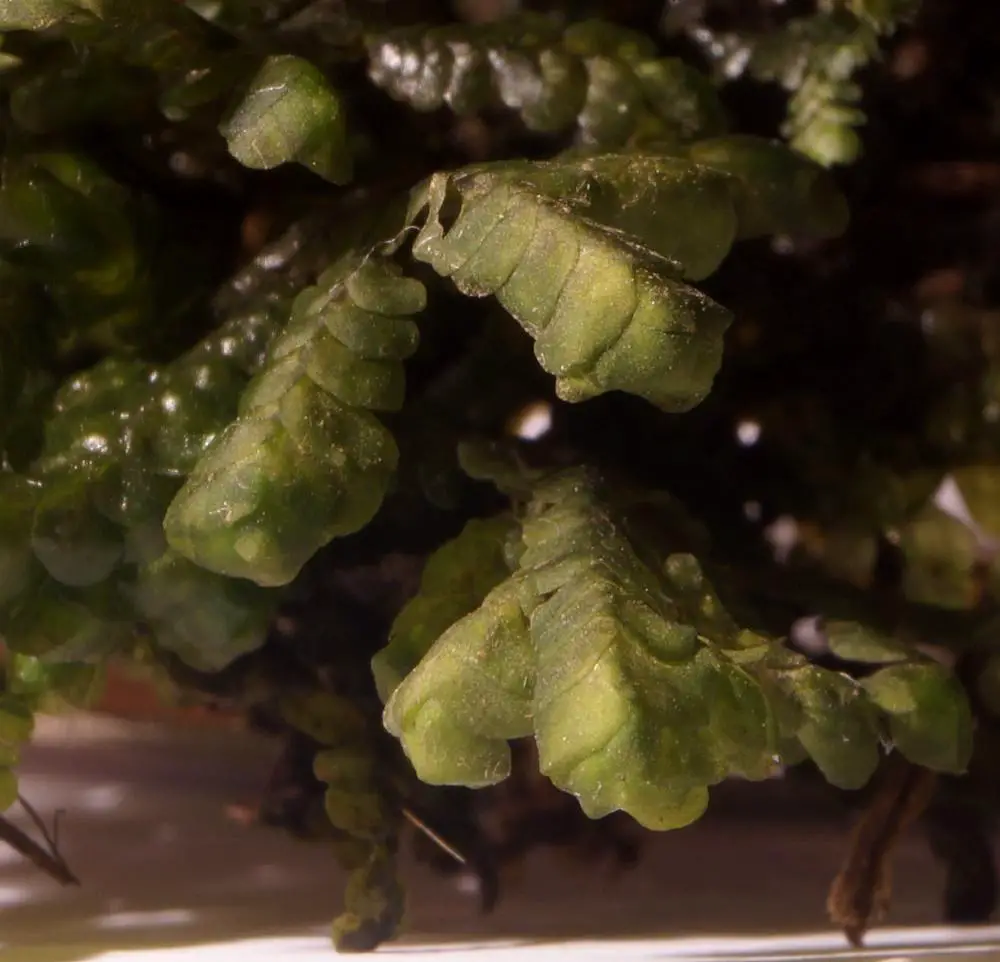
porella-pinnata-dorsal.jpg from: https://headwatersmn.org/2019/04/01/pursuing-liverworts-in-rockingham-county/porella-pinnata-dorsal/
Introduction
Welcome, fellow enthusiasts, to an exploration of the captivating world of Porella plumosa (Mitt.) Parihar, a moss species that belongs to the Porellaceae family. Also known simply as Porella, this unassuming yet remarkable plant has captured the hearts and minds of bryologists and nature lovers alike. Let’s delve into the fascinating details of this diminutive wonder.
Background
Before we dive into the specifics of Porella plumosa, it’s essential to understand its place within the broader context of the plant kingdom. This moss species falls under the division Marchantiophyta, which encompasses liverworts, hornworts, and mosses. More specifically, it belongs to the class Jungermanniopsida, a group of leafy liverworts known for their intricate and delicate structures.
Main Content
Morphology and Identification
Porella plumosa is a small, creeping moss that forms dense mats or cushions on various substrates. Its stems are slender and irregularly branched, with closely overlapping leaves arranged in two rows. These leaves are ovate to oblong in shape, with a distinctive plicate (folded) appearance. The leaf margins are often toothed or ciliate, adding to the plant’s intricate beauty.
One of the most striking features of Porella plumosa is its vibrant green color, which can range from deep emerald to a lighter, yellowish-green hue. This coloration is due to the presence of chloroplasts, which are responsible for photosynthesis and give the moss its lush, verdant appearance.
Global Distribution and Habitat
Porella plumosa is widely distributed across various regions of the world, including Europe, Asia, North America, and parts of South America. It thrives in a variety of habitats, from moist and shaded forests to rocky outcrops and even urban environments, where it can be found growing on tree bark, rocks, and soil.
This moss species is particularly well-adapted to humid and cool environments, making it a common sight in temperate and boreal regions. However, it can also be found in tropical and subtropical areas, where it often seeks refuge in shaded and moist microhabitats.
Ecological Roles and Adaptations
Despite its diminutive size, Porella plumosa plays a crucial role in its ecosystem. As a pioneer species, it helps stabilize and enrich soil, creating favorable conditions for other plants to establish themselves. Additionally, it provides a habitat and food source for various invertebrates, contributing to the overall biodiversity of its environment.
One of the remarkable adaptations of Porella plumosa is its ability to withstand desiccation. During periods of drought, the moss can enter a state of dormancy, curling up its leaves and slowing down its metabolic processes. Once moisture returns, it quickly revives, showcasing its resilience and ability to thrive in challenging conditions.
Case Studies/Examples
In a recent study conducted in the Pacific Northwest region of North America, researchers discovered that Porella plumosa played a vital role in maintaining the moisture levels and nutrient cycling within old-growth forests. The moss’s ability to absorb and retain water, coupled with its capacity to break down organic matter, contributed significantly to the overall health and productivity of these ecosystems.
Technical Table
| Characteristic | Description |
|---|---|
| Scientific Name | Porella plumosa (Mitt.) Parihar |
| Family | Porellaceae |
| Division | Marchantiophyta |
| Class | Jungermanniopsida |
| Growth Form | Creeping, mat-forming |
| Leaf Arrangement | Two rows, overlapping |
| Leaf Shape | Ovate to oblong, plicate |
| Leaf Margin | Often toothed or ciliate |
| Color | Deep emerald to yellowish-green |
| Habitat | Moist, shaded forests, rocky outcrops, tree bark, soil |
| Distribution | Europe, Asia, North America, South America |
Conclusion
Porella plumosa is a true marvel of nature, a testament to the incredible diversity and resilience of the moss world. From its intricate morphology to its vital ecological roles, this unassuming plant has captured our hearts and minds. As we continue to explore and appreciate the wonders of the natural world, let us ponder this thought-provoking question: What other hidden gems await our discovery, and how can we better protect and preserve these invaluable treasures?